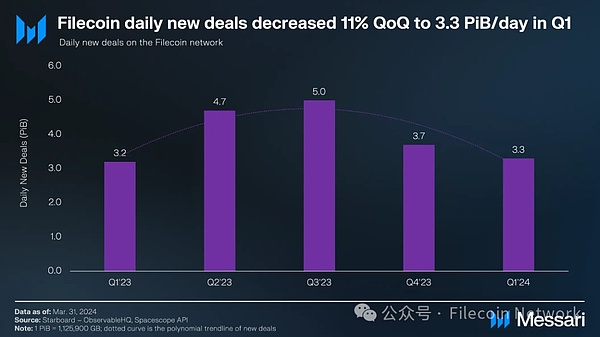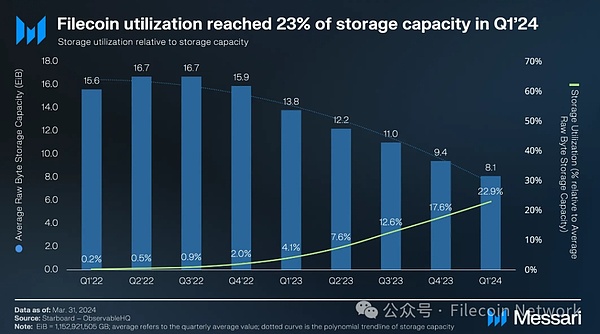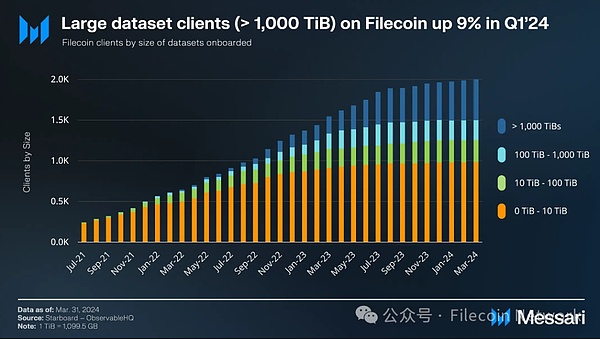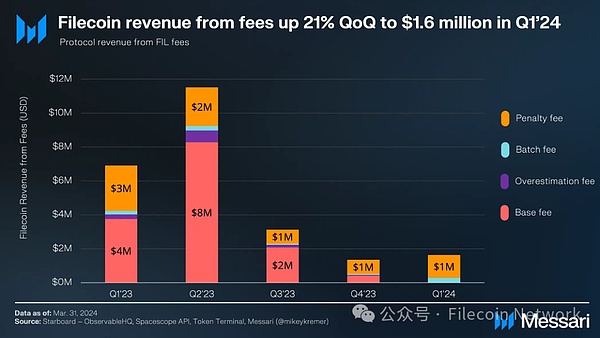Filecoin 2024 Review and 2025 Outlook
Recap key milestones for 2024 and examine the key growth drivers for Filecoin’s development in 2025.
 JinseFinance
JinseFinance
Key Points
The Filecoin storage market grew in Q1 2024, with active transactions up 9% from the previous quarter. Storage utilization increased from 18% in Q4 2023 to 23% in Q1 2024, while storage capacity decreased by 14% from the previous quarter.
As of the end of Q1 2024, more than 2,000 users had loaded datasets on Filecoin, of which 508 users had loaded large datasets (larger than 1,000 TiB), up 9% from the previous quarter.
One year after the launch of the Filecoin Virtual Machine (FVM) in Q1 2023, the DeFi ecosystem continues to grow - Pyth and Uniswap V3 (Oku.trade) launched in Q1 2024, and GLIF deposits grew more than 2x month-on-month.
As of March 31, 2024, FVM deployed more than 3,400 unique contracts, up 26% month-on-month from 2,700 at the end of Q4 2023. Meanwhile, FVM’s TVL exceeded $600 million in Q1 2024, nearly 2x month-on-month, largely due to liquidity staking.
In addition to growing the FVM ecosystem, Filecoin is focused on increasing enterprise adoption in the short term and developing DePIN partnerships in the long term to leverage idle computing resources.
Filecoin Basic Information
Filecoin is building a hardware market - the first service is storage. Filecoin is built on IPFS (Interplanetary File System) and uses transactions that price storage based on a provider market rather than a fixed pricing structure (https://filecoin.io/blog/posts/how-storage-and-retrieval-deals-work-on-filecoin/). A storage transaction is like a contract with a service level agreement (SLA: https://www.cio.com/article/274740/outsourcing-sla-definitions-and-solutions.html) - users pay storage providers to store data for a specified period of time.
To ensure data security, Filecoin uses a cryptoeconomic incentive model to periodically verify (https://filecoin.io/blog/posts/zero-knowledge-and-the-filecoin-network/) storage through zero-knowledge proofs (https://messari.io/report/the-zk-everything-report). To incentivize storage providers to participate in storage transactions, Filecoin rewards them with the network's native token FIL. If storage providers fail to provide reliable online time or take malicious actions against the network, they will also be punished accordingly (https://docs.filecoin.io/storage-provider/filecoin-economics/slashing/).
To retrieve data, Filecoin users pay retrieval providers to obtain data. Unlike storage transactions that involve on-chain transactions, retrieval transactions use payment channels to settle off-chain payments, allowing for faster retrieval. In addition to storage and retrieval, Filecoin aims to provide an open market where data can be run by contracting computing power, providing a more efficient alternative to traditional centralized storage.
Key protocol upgrades to enable data computing services include smart contracts (Filecoin Virtual Machine - FVM) (https://fvm.filecoin.io/) and extensions (Interstellar Consensus) (https://ipc.space/). The Filecoin Virtual Machine, launched in March 2023, will introduce Ethereum-style smart contracts to Filecoin, which will promote new use cases in areas including liquidity staking, perpetual storage, and decentralized computing.
Website (https://filecoin.io/) / X (Twitter:https://twitter.com/Filecoin)
Performance Analysis
The Filecoin blockchain is used to decentralize data storage in the following ways:
Demand side, that is, storage users who need data storage.
Supply side, that is, storage providers with excess network capacity.
Network side
The amount of data stored in active exchanges between storage users and storage providers measures the demand for Filecoin storage.
Storage Transactions

In the first quarter of 2024, Filecoin continued to adopt decentralized storage through active transaction growth. Through active transactions in the first quarter, nearly 1,900 PiB were stored on the Filecoin network, a 9% month-on-month increase from 1,700 PiB in the fourth quarter of 2023, and a more than 3-fold year-on-year increase from 600 PiB in the first quarter of 2023.

At the same time, the daily new transaction volume continued to decline by 11% month-on-month to 3.3 PiB/day after reaching an all-time high of 5 PiB/day in the third quarter of 2023. Although new transactions are still growing, the month-on-month slowdown in daily new transactions corresponds to an overall reduction in storage provider rewards (see the "Rewards" section below for details). In addition, the increase in new transactions helps to improve the utilization of the Filecoin network.
Storage Utilization vs. Capacity

Filecoin storage utilization relative to total available storage capacity grew to nearly 23% in Q1 2024, up from 18% in Q4 2023. While this growth is a positive sign for Filecoin adoption through active storage trading, it must be placed in the context of network capacity.
Filecoin average raw bytes of storage capacity fell 14% quarter-over-quarter to 8.1 EiB in Q1 2024. This metric has been declining since reaching an all-time high of nearly 17 EiB in Q2 and Q3 2022, about two years ago.
The decline in storage capacity is further reflected in the decline in the total number of storage providers. After reaching an all-time high of more than 4,100 in the third quarter of 2022, the indicator fell to about 3,000 in the first quarter of 2024.
In addition to storage, decentralized protocols are increasingly using Filecoin to access idle computing resources. For example, the decentralized computing platform io.net (http://io.net/) integrated (https://finbold.com/io-net-expands-filecoin-storage-use-cases-through-collaboration/) 1,500 GPUs of Filecoin storage providers in December 2023 to increase GPU computing power.
Storage Users
Messari's Guide to Decentralized Storage Networks (https://messari.io/report/the-essential-guide-to-decentralized-storage-networks) shows that Filecoin is currently suitable for providing cold storage solutions (such as archiving and recovery) for enterprises and developers. Its competitive price helps attract traditional enterprises seeking cost-effective alternatives to store large amounts of archival data.
Related cases include: Banyan(https://www.banyan.computer/) - focusing on packaging services to make it easier for enterprise users to get started; Seal(https://www.sealstorage.io/) - focusing on providing storage entry for large customers, such as UC Berkeley (https://www.sealstorage.io/blog/uc-berkeley-uses-web3-decentralized-storage-for-neutrino-research-data), StarlingLabs(https://www.youtube.com/watch?v=sX6F9_JoxaA), the Atlas Experiment(https://atlas.cern/updates/news/hllhc-data-storage)) and Casper Network(https://www.youtube.com/watch?v=UkkQ5CMtTs4); Steeldome (youdaoplaceholder0) ——Focus on enterprise data archiving, backup and recovery. Some other efforts outside of cold storage are driven by solutions from companies such as Lighthouse(https://twitter.com/LighthouseWeb3/status/1477914886621458433), RIBS(https://github.com/FILCAT/ribs), Retriev(https://cryptonet.org/projects/data-retrievability) and Flamenco(https://flamenco.blender.org/usage/shared-storage/).

As of the end of the first quarter of 2024, a total of 2,007 users (https://app.periscopedata.com/shared/d33c4430-465c-40ba-956f-76e43880eba9?) have stored datasets on Filecoin, of which 508 users have stored large datasets (i.e., datasets with a storage size of more than 1,000 TiB), an increase of 9% from 465 in the fourth quarter of 2023. To encourage use through active transactions, we provide a variety of storage services, including NFT.storage (https://nft.storage/), Web3.Storage (https://web3.storage/), and Steeldome (https://www.steeldomecyber.com/).
According to Filecoin Client Explorer (https://destor.com/en-us/filecoin-network-client-explorer), major users include Starling Lab, NFT platform OpenSea (https://filecoin.io/blog/posts/opensea-decentralizes-and-persists-nft-storage-with-ipfs-and-filecoin/), Layer-1 network Solana (https://twitter.com/triton_one/status/1681761297170325506). Other notable institutions using the Filecoin network are as follows:
Victor Chang Cardiac Institute maintains and shares research data (https://blockworks.co/news/filecoin-cardiac-institute-decentralized-storage).
Democracy’s Library stores datasets collected by the Internet Archive at the end of its administration (https://fil.org/blog/democracy%E2%80%99s-library-announces-more-than-a-petabyte-of-government-data-uploaded-to-the-filecoin-network/).
SETI Institute uses Filecoin to store astronomical research data (https://destor.com/seti).
UC Berkeley collaborates with Seal Storage for storage physics research (https://www.newswire.ca/news-releases/uc-berkeley-engages-seal-storage-web3-technology-to-advance-innovative-neutrino-physics-research-883282087.html).
GenRAIT uses Estuary to store critical genomic data on Filecoin (https://filecoinfoundation.medium.com/case-study-genrait-leverages-filecoin-network-for-greater-visibility-access-and-storage-of-1d56897a2d73).
Research center Starling Lab stores sensitive digital records of human history (https://medium.com/@FFDWeb/announcing-the-starling-lab-4f1ce0204f07).
Ewesion (China’s fastest growing graphics file host) uses Filecoin for data storage (https://filecoinfoundation.medium.com/storage-company-ewesion-leverages-filecoin-network-for-data-preservation-e36cecc84e0e).
DeSci Labs uses decentralized data storage on Filecoin to enable research to be replicated and independently verified by other researchers (https://fil.org/blog/case-study-desci-labs-and-filecoin-enabling-a-future-of-open-science/).
Opscientia (OpSci) makes it easier for scientists around the world to share data by using Filecoin (https://fil-foundation.on.fleek.co/hosting/OpSci-CaseStudy.pdf).
Destor and Seal Storage are working with Cyber SMART (https://destor.com/resources/news/seal-storage-filecoin-destor-ai-data-integrity-project) on the AI Data Integrity Improvement Research Project, an industry-university collaboration funded by the National Science Foundation and industry members.
An overview of Filecoin’s featured users can be viewed here (https://filecoin-explorer.com/expanded-view?__hstc=224880773.3fb633f764c45c8b1c96d01937fceede.1696881075314.1697063173784.1697098377625.3&__hssc=224880773.1.1697098377625&__hsfp=100422932).
Retrieval
To meet storage retrieval needs, a Filecoin and IPFS content delivery network called the Saturn project (https://docs.filecoin.io/basics/how-retrieval-works/saturn/) has been developed and is currently running in closed testing. The Saturn project aims to provide retrieval services in the Filecoin ecosystem through fast and low-cost content delivery. Saturn node operators currently earn FIL to meet retrieval requests, but it is expected that they will move to demand-based long-term incentives.
Meanwhile, the Station(https://www.filstation.app/) application brings decentralized retrieval to the desktop, while the SPARK(https://www.youtube.com/watch?v=aDWz3DTnOYI) and Voyager(https://twitter.com/FilecoinStation/status/1757805439410950265) modules allow retrieval checks on the network. For context, Station uses idle computing resources and provides FIL rewards. As of March 2024, Station's computing network has more than 7,700 participants (https://twitter.com/filecoin/status/1770573869721473503?s=61&t=0-vyAwkNO-FuEIxq0bsRhg).
Saturn aims to provide reliable content retrieval for enterprise and crypto-native use cases. A recent example of a user deployment is Saturn’s retrieval support for Solana’s NFT platform Metaplex (https://www.metaplex.com/).
As the pilot phase is completed, Saturn is expected to enter the upgrade phase. Once in this phase, the existing CDN product will be transformed in the next few quarters and re-launched as part of a more scalable, high-performance independent retrieval protocol with its own incentive system.
FVM Usage
The Filecoin Virtual Machine (FVM) was launched in Q1 2023, bringing Ethereum-style smart contracts to Filecoin. A year after its launch, Uniswap V3 was released on FVM in Q1 2024 (https://twitter.com/FilecoinTLDR/status/1763290288003391675). The Uniswap deployment on FVM enables developers to use ETH and USDC in the Filecoin ecosystem.
Binance recently announced (https://www.binance.com/en/support/announcement/binance-completes-integration-of-filecoin-fil-on-filevm-network-opens-deposits-5af3fc32fe71451ba942799189ae4d0a) the opening of FIL deposits after FVM integration. Previously, Sushi (https://www.sushi.com/blog/sushi-is-live-on-filecoin) integrated with Filecoin and began to use Axelar (https://axelar.network/blog/filecoin-cross-chain-datadaos-axelar-and-fvm) and Celer (https://blog.celer.network/2023/03/20/celer-cbridge-and-im-support-launched-on-the-filecoin-virtual-machine-fvm/) to achieve inter-chain communication. At the same time, the leading Solana oracle Pyth was launched on FVM, and Filecoin smart contract developers can now use Pyth price feed services to further support the development of the Filecoin DeFi ecosystem.
As of March 31, 2024, more than 3,400 independent contracts were deployed on FVM (https://dashboard.starboard.ventures/fvm#total-unique-contracts-deployment), a 26% increase from the 2,700 at the end of the fourth quarter of 2023. At the same time, FVM TVL exceeded US$600 million in the first quarter of 2024, nearly doubling from the previous quarter.

According to FVM Explorer statistics (https://fvm.starboard.ventures/explorer), as of the end of the first quarter of 2024, the total net deposits of DeFi were 27 million FIL (approximately US$256 million), mainly used for staking, liquidity staking (https://filecointldr.io/how-to-stake-filecoin) and DEX. Liquidity staking protocol GLIF (https://www.glif.io/en) accounts for the majority of deposits (https://www.dlnews.com/articles/defi/filecoin-is-riding-the-boom-in-liquid-staking/) (52% by the end of the first quarter of 2024), followed by SFT protocol (10%) (https://www.sftproject.io/), Repl (9%) (https://www.repl.fi/) and other protocols (29%). Related background: GLIF released (https://medium.com/@glifio/liquid-leasing-a-new-chapter-for-filecoin-defi-8eb52dbdb7e9) a reward program to incentivize DeFi community participation.
Repl introduced (https://medium.com/@z1286679231/restaking-brings-new-vitality-to-filecoin-filecoin-defi-ecological-project-repl-67a2b1e82f17) a mechanism for storage providers to lock FIL and get rewards.
FILLiquid (https://filliquid.io/) proposed to provide FIL loans to storage providers (https://medium.com/@FILLiquid/three-reasons-why-filliquid-is-the-best-fil-lending-market-in-crypto-d4d9722a9638).
Thetanuts Finance (https://www.thetanuts.finance/) launched a FIL-covered call option insurance vault to earn returns.
At the same time, according to the FVM DeFi leaderboard (https://fvm.starboard.ventures/explorer/leaderboard), as of March 31, 2024, the total net borrowing in DeFi reached 17 million FIL (about US$162 million). In the first quarter of 2024, both monthly net deposits and borrowings showed rapid growth, consistent with the risk market. As FVM continues to develop, it may become the basis for developing monetizable FVM data use cases.
Financial aspects
Filecoin's revenue framework is similar to Ethereum, as its Gas system is designed based on the EIP-1559 mechanism (https://filecoin.io/blog/posts/eip-1559-in-filecoin/). The Gas system consists of network fees, which are burned to compensate for the resources used. Both storage users and storage providers generate protocol revenue.
Revenue
According to Messari's revenue analysis (https://messari.io/article/demystifying-filecoin-s-revenue), Filecoin protocol revenue includes the sum of the following four items:
Base fees - depending on the message congestion, any storage proof is required.
Batch fees – used when packaging storage proofs in batches.
Overestimation fees – used to optimize gas usage.
Penalty fees – fines when storage providers fail.

While demand for Filecoin storage has grown, fee revenue grew 21% to $1.6 million in the first quarter of 2024. The reduction in storage capacity is reflected in the increase in penalty fees and batch fees. Notably, the base fee for storage transactions is just over $8,400, which is consistent with the overall decline in demand-side fees charged to users in the decentralized cloud storage space. Organizations including the Decentralized Storage Alliance (DSA) (https://dsalliance.io/about) are actively working to reduce the cost of loading data on the Filecoin network (https://filecoin.io/blog/posts/dsa-reduces-decentralized-storage-costs-by-40-percent/).
Rewards
Filecoin rewards include:
Block rewards distributed by the network to storage providers.
“Tips” fees used to speed up transactions.
In the first quarter of 2024, block rewards constituted more than 99.9% of supply-side revenue, while “tips” accounted for only a small part. The new FIL token minting mechanism (https://spec.filecoin.io/systems/filecoin_token/minting_model/#:~:text=Baseline%20minting%20allocation%20mints%20more,of%20minting%20filecoin%20too%20quickly.) relies on the following two:
Exponential decay model (30% of total supply): To encourage participation, block rewards are highest in the early days. Over time, they decay exponentially.
Baseline model (70% of total supply): Block rewards are distributed as storage capacity increases.
The combination of these two models helps to maintain participation after the early block reward distribution period of the network ends (see exponential decay model), and also helps to continue to reward the additional value brought to the network by the increase in network storage capacity (see baseline model).

Driven by the rise in FIL/USD prices, supply-side rewards increased by 39% from $55 million in the fourth quarter of 2023 to $76 million in the first quarter of 2024. On the FIL side, rewards fell from 12.6 million FIL in the fourth quarter of 2023 to 10.6 million FIL in the first quarter of 2024, a decrease of 16%. The exponential decay model and the baseline minting model lead to an overall reduction in FIL reward issuance (https://spec.filecoin.io/systems/filecoin_token/block_reward_minting/).
FIL reward issuance may continue to decrease in the coming quarters. For an in-depth discussion and various simulations of future FIL issuance, please refer to Messari's recent research on FIL circulating supply (https://messari.io/report/cryptoecon-series-investigating-fil-circulating-supply).
Ecosystem Overview
The Filecoin ecosystem (https://ecosystem.filecoin.io/?results=115) has been actively attracting developers and builders, and it regularly participates in activities such as hackathons, accelerators, sponsorship programs, mentor programs, and growth support. These programs are designed to help early projects and teams grow so that they can expect to receive financial support from Protocol Labs or its affiliated entities. The Filecoin ecosystem is committed to introducing diverse use cases ranging from data infrastructure, streaming, metaverse to games.
As of March 2024, there are over 160 known projects in the Filecoin Ecosystem Explorer (https://fil.org/ecosystem/), a non-exhaustive database of community network projects. Most projects using Filecoin provide data services:
Banyan(https://protocol.ai/blog/meet-banyan-reimagining-cloud-data-storage/): Web2-like decentralized storage for areas beyond corporate archives.
Lighthouse(https://twitter.com/LighthouseWeb3/status/1477914886621458433): Permanent data storage service with a one-time payment pricing model.
Numbers Protocol(https://protocol.ai/blog/meet-numbers-protocol-building-authenticity-in-the-age-of-generative-ai/): Maintaining data authenticity for digital media and generative AI.
Seal Storage(https://www.sealstorage.io/): Immutable data storage solution.
Steeldome(https://www.steeldomecyber.com/): Data protection and data storage solution.
Fluence (https://fluence.network/): Enables developers to scale their Web3 projects.
EQTY Lab(https://www.eqtylab.io/): Uses cryptographic methods to verify snapshots of AI model lineages, leveraging decentralized technologies such as IPFS and Filecoin to anchor model data.
Tableland(https://tableland.xyz/): SQL-based cloud database.
Basinv2(https://github.com/tablelandnetwork/basin-provider): Data management and collaboration, used by Tableland, WeatherXM(https://mirror.xyz/tableland.eth/jxWM36j7OaW4plfTlpQpgRrIDuth75lJhVjj0BiFwBA) network and Bacalhau(https://www.bacalhau.org/) computer network.
Wb3mine(https://www.web3mine.io/): Monetization of idle computing power.
Protocols focused on media and entertainment include:
Mona(https://monaverse.com/):3D art gallery in the metaverse.
Huddle01(https://huddle01.io/):Decentralized video conferencing.
OPGames(https://www.opgames.org/):Game-related NFT minting.
FileMarket(https://filemarket.xyz/):Web3 store builder and marketplace.
The following use cases aim to leverage Filecoin infrastructure to drive data needs in specific areas:
Cryptosat(https://protocol.ai/blog/satellites-for-crypographic-protocols/): Use mini satellites to prevent side-channel attacks and achieve secure verification.
ZKsig NFT(https://ethglobal.com/showcase/zksig-nfts-j597n): Market access control.
DataMarket(https://ethglobal.com/showcase/datamarket-instant-data-purchase-pages-zz5z0): Data purchase and settlement functions.
Qualitative Analysis
Key Developments
V22 Network Upgrade (Dragon)
The scope of the V22 upgrade (Dragon) includes several improvement proposals:
FIP-0063(https://github.com/filecoin-project/FIPs/blob/master/FIPS/fip-0063.md): Switch to the new Drand mainnet network.
FIP-0074(https://github.com/filecoin-project/FIPs/blob/master/FIPS/fip-0074.md): Cancel Cron-based automatic transaction settlement.
FIP-0076(https://github.com/filecoin-project/FIPs/blob/master/FIPS/fip-0076.md): Direct data loading.
FIP-0083(https://github.com/filecoin-project/FIPs/blob/master/FIPS/fip-0083.md): Add built-in Actor Events to verified registries, storage providers, and market participants.
Uniswap V3 Deployment
After a successful governance vote in October 2023 (https://twitter.com/FilecoinTLDR/status/1763290288003391675), Uniswap V3 (via Oku.trade) was deployed on the Filecoin Virtual Machine (FVM) (https://twitter.com/FilecoinTLDR/status/1763290288003391675). The deployment is supported by Axelar as a deployer and bridge provider. Specifically, it allows bridged ETH and USDC to be used natively on the FVM, increasing Filecoin’s relevance to DeFi applications.
Solana Integration
The Solana team is working to archive Solana’s block history on Filecoin (https://twitter.com/aeyakovenko/status/1758737369220681895). Once completed, Solana data will be more accessible to infrastructure providers, explorers, and data indexers. Solana will benefit from greater redundancy and enhanced security. In addition, price information from Solana’s leading oracle Pyth is now available on Filecoin (https://twitter.com/PythNetwork/status/1752354848987570374?s=20).
Fluence is powered by IPC
Fluence Network announced the launch of a decentralized computing platform powered by Filecoin Interplanetary Consensus (IPC) (http://ipc.space/). The launch of IPC enables services such as aggregators, hot storage, and compute networks to be built on Filecoin. To help achieve this, FVM leverages valid proofs to verify computational integrity and introduces faster proof of capacity verification for load providers. Fluence benefits from this partnership due to low transaction costs and fast finalization.
Pyth prices are based on FVM
The leading Solana oracle Pyth is launched on FVM (https://pyth.network/blog/pyth-price-feeds-launch-on-filecoin-vm) with over 400 data sources. Today, Filecoin smart contract developers can use Pyth price feeds, thereby supporting the further development of the Filecoin DeFi ecosystem.
Key Events
FIL Development Summit
The FIL Development Summit (https://fildev.io/) continued its third session at ETHDenver 2024 (https://www.ethdenver.com/), focusing on Filecoin’s programmable storage, archival use cases such as Solana, and upcoming Filecoin hot storage layer innovations (https://filecoin.io/blog/posts/fil-dev-summit-track-on-smart-storage--dapps-archiving-solana-on-filecoin-filecoins-relationship-to-da-ipc-l2s-fast-finality-and-more/).
IPFS in Space
The Filecoin Foundation (FF) announced in January (https://fil.org/blog/filecoin-foundation-successfully-deploys-interplanetary-file-system-ipfs-in-space/) that it had completed a demonstration of using IPFS to enable space communications, sending files from Earth to orbit and back. This demonstration was part of a collaboration with the aerospace company Lockheed Martin.
Digital Art Archive
The Museum of Crypto Art launched ROOMs Archive (https://archive.museumofcryptoart.com/), a digital archive that uses Filecoin to permanently preserve snapshots as digital galleries.
Key Governance Decisions
Retroactive Public Goods Funding
To recognize Filecoin network contributors, the first round of retroactive public goods funding program FIL-RetroPGF-1 (https://app.optimism.io/retropgf) will award 200,000 FIL (approximately $1.9 million). This program aims to fund contributions that have an impact on Filecoin through Optimism's Retroactive Public Goods Funding (https://medium.com/ethereum-optimism/retroactive-public-goods-funding-33c9b7d00f0c).
Summary
The Filecoin storage market continued to grow in the first quarter of 2024, with active transactions increasing by 9% month-on-month. Storage utilization increased from 18% in Q4 2023 to 23% in Q1 2024, while storage capacity decreased by 14% QoQ. As of the end of Q1 2024, more than 2,000 users had loaded datasets on Filecoin, of which 508 users had loaded large datasets (larger than 1,000 TiB), up 9% from 465 in Q4 2023. Rewards increased by 39% from $55 million in Q4 2023 to $76 million in Q1 2024 due to higher FIL/USD prices. On the FIL side, rewards decreased by 16% QoQ due to a decrease in the total amount of FIL issued.
One year after the launch of FVM, Uniswap V3 was launched on FVM in Q1 2024. The Uniswap deployment on FVM enables developers to use ETH and USDC in the Filecoin ecosystem.
As of March 31, 2024, more than 3,400 independent contracts were deployed on FVM, a 26% increase from 2,700 at the end of the fourth quarter of 2023. At the same time, FVM TVL exceeded US$600 million in the first quarter of 2024, nearly doubling from the previous quarter. Both net deposits and loans in the first quarter of 2024 showed a rapid growth trend, consistent with the risk market. As FVM continues to gain traction, it will become the basis for developing monetizable FVM use cases around data and computing.
If you want to let us know what you like about this report, what's missing, and other ideas, please fill out this short form (https://06jiny4c1wy.typeform.com/to/DsmsVsUp?typeform-source=www.google.com#research=state-of-filecoin-q2-2023). All feedback is subject to our Privacy Policy (https://messari.s3.amazonaws.com/privacy.html) and Terms of Service (https://messari.s3.amazonaws.com/termsofuse.html).
If you are also interested in Filecoin, welcome to learn more:
Website: https://filecoin.io/zh-cn/
Slack channel: filecoin.io/slack/
Twitter: @Filecoin
Blog: https://filecoin.io/zh-cn/blog/
Chinese News Update: https://t.me/filecoinchn
Filecoin Insights: https://tldr.filecoin.io/
Recap key milestones for 2024 and examine the key growth drivers for Filecoin’s development in 2025.
 JinseFinance
JinseFinanceThe crypto market has been unpredictable recently, and many people have begun to think that this is a strange bull market, and no one is making money. Many people even complain that this is the most difficult Bitcoin bull market in history to make money!
 JinseFinance
JinseFinanceVC Coin, Meme, Cyclical Phenomenon: Is Value Coin Really Dead? Golden Finance, Market Performance Comparison of Value Coin and Meme Coin: Which One Is Better?
 JinseFinance
JinseFinanceHas Bitcoin peaked? Is the bull run over? What opportunities are there for ordinary people?
 JinseFinance
JinseFinanceDoes Filecoin still have a chance in this bull market? Is there still hope for the 1000U goal?
 JinseFinance
JinseFinanceInvestment firm Valkуrie Funds expects the number of active spot Bitcoin ETFs to drop to seven to eight by the end of the year due to high stock management costs and low profits from competition.
 JinseFinance
JinseFinanceFilecoin DeFi basic primitive GLIF completed a round of financing of US$4.5 million, led by Multicoin Capital
 JinseFinance
JinseFinanceIt cited regulatory concerns as the reason behind the move.
 Others
OthersOne of the U.S. and Brazil's biggest Bitcoin ATM operators, Coin Cloud, filed for Chapter 11 Bankruptcy on Thursday, January 8.
 Bitcoinist
BitcoinistThe commission said it would be seeking “permanent injunctions, disgorgement with prejudgment interest, civil penalties against and conduct-based injunctions."
 Cointelegraph
Cointelegraph